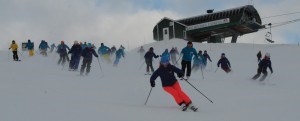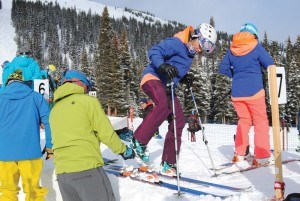
The last time Marmot Basin hosted Ski Canada’s annual ski test, skis were straight and narrow; florescent outerwear was the rule, not the exception; and mullets were still in fashion.
Since then a lot has changed.
Last week, Marmot hosted the magazine’s annual ski test for the first time since 1984 and only the fifth time since the magazine’s inaugural test in 1980.
If you look back on those early years, Marmot played an integral role in the magazine’s test, thanks to the likes of Ward Jones of Wild West Ski Shoppes, who conducted the magazine’s first on-slope test in 1980.
“Who knows if we ever would have done ski testing had it not been for that first initiative,” said Paul Green, the owner and publisher of Ski Canada Magazine, who was at Marmot Basin last week.
The following year there were no test reports, but in 1982 Blair Timmins of Edge Control took up the cause with a more extensive on-slope test and continued his tests for the magazine for the next two years, before it moved to Lake Louise in 1985.
“There were a lot of discussions at the time about whether this was a quality testing procedure or whether the guys were just voting for their favourite ski and how serious they were about it,” recalled Green, who has owned the magazine for the last 25 years.
“There were questions about what it might do in terms of offending advertisers and whether we should be doing this at all, because many magazines wouldn’t go near the idea of testing skis.”
Despite initial hesitations, Ski Canada continued to publish the annual test every fall and it quickly became the go to source for people interested in purchasing a new pair of skis or boots.

According to Green, a large part of the test’s early success was its commitment to carrying out honest and impartial evaluations that avoided playing favourites.
“Some skis, especially back in those days, were just terrible,” said Green.
“We had several skis back in the early years that half way through the test we had to tell everybody to stop skiing them because somebody was going to get hurt.”
Today the test follows strict procedures and includes dozens of ski brands and ski styles from on-piste cruisers to big mountain skis. In all, there are six categories.
Few people know skis better than Mark Stein, who has been testing the latest and greatest skis to hit the market for the past 25 years.
He was one of 37 skiers at Marmot last week, testing 124 pairs of skis over four days.
“When I started testing we were on 205 [cm] slalom skis and 210 [cm] giant slalom skis and they were still the straight skis,” said Stein, who is the head coach of the Edmonton Ski Club, which regularly trains at Marmot.
He said the first time he tried carving skis was in the mid 90s during a ski test at Lake Louise.
“There were only two skis out of 60 that had this new shape and we really didn’t know what is was all about, but we tried them and thought there was something there,” recalled Stein.
“We didn’t really understand that that was the future.”
Within two seasons, shaped skis were everywhere, changing the future of skiing forever.
According to Stein, the other big improvement at the time was a change in the construction of skis.
“Building a ski is all about separating the flex of the ski with the torsion and if you made a ski wider you couldn’t keep it soft enough to bend, but stiff enough so it didn’t fold out of the turn, so ski construction improved with the new shape.”
As companies started to find that balance, skis gradually got fatter, allowing skiers to stay on top of the snow. But with that new style also came a downside.
“As they got fatter they got tougher to ski, but in the last few years now they have been able to build these wide skis under foot that are quite quick and agile.”
To conduct the test, each ski is covered in blue tape so skiers don’t know what brand or model of ski they are testing.
Each tester then takes the skis out for a single run to test each ski’s strengths and weaknesses from its edge grip to its versatility. Each characteristic is evaluated using a 10-point scale and is given an overall score.
“Every ski is different. I’ve probably skied on more than 2,000 pairs of skis over those 25 years and not a single pair has been identical, they’re all different,” said Stein, adding nowadays it’s hard to find a bad pair of skis.
Paul Clarke [email protected]
